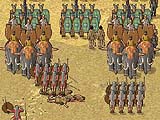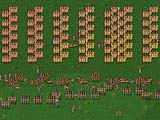 |
The Second Punic War pitted Rome and Carthage against each other in a dead-serious struggle for domination of the Mediterranean world. Rome won, and in the end Carthage was laid waste. But it was a dramatic and near-run thing. The Carthaginians, under the command of the brilliant Hannibal, made a legendary crossing of the Alps, razed the Roman countryside, and defeated every Roman army thrown at them. Only a Hannibal's inability to maintain his army (made up mostly of mercenaries), Roman naval superiority, and the brilliant generalship of Rome's Scipio Africanus kept the Mediterranean from becoming a Carthaginian, rather than a Roman, lake.  In many ways, the war between Carthage and Rome is a study in
contrasts. The Roman army, especially before Scipio, is very much a "three yards in a
cloud of dust" machine. Velites (the famous wolf-skinned light infantry) lead off
attacks by skirmishing and then withdrawing, after which the main attack is launched by
the legion's heavy infantry, the hastati and the principes, who tend to run it right up
the middle. The veteran triarii, in the meantime, stay to the rear and serve as a reserve
or last line of defense if all goes wrong. It's all pretty predictable, though it's often
pretty devastating as well. The Carthaginians, on the other hand, are more of a
run-and-shoot kind of army. Made up of as diverse a bunch of troops as
imaginable--Balearic slingers, Celtic and Gaul medium infantry, Hispanic heavy infantry,
phalanxes, elephants, Numidian light cavalry--there is no set-in-stone Carthaginian
tactical doctrine. While the strength of the Romans is their heavy infantry and manipular
tactical doctrine, the Carthaginians must attack the flanks, set traps, try to find a way
to turn the Romans' head-on superiority against itself. In many ways, the war between Carthage and Rome is a study in
contrasts. The Roman army, especially before Scipio, is very much a "three yards in a
cloud of dust" machine. Velites (the famous wolf-skinned light infantry) lead off
attacks by skirmishing and then withdrawing, after which the main attack is launched by
the legion's heavy infantry, the hastati and the principes, who tend to run it right up
the middle. The veteran triarii, in the meantime, stay to the rear and serve as a reserve
or last line of defense if all goes wrong. It's all pretty predictable, though it's often
pretty devastating as well. The Carthaginians, on the other hand, are more of a
run-and-shoot kind of army. Made up of as diverse a bunch of troops as
imaginable--Balearic slingers, Celtic and Gaul medium infantry, Hispanic heavy infantry,
phalanxes, elephants, Numidian light cavalry--there is no set-in-stone Carthaginian
tactical doctrine. While the strength of the Romans is their heavy infantry and manipular
tactical doctrine, the Carthaginians must attack the flanks, set traps, try to find a way
to turn the Romans' head-on superiority against itself.All of this makes for very exciting gameplay, and IM has done a fine job of modelling the classical battlefield. The most important factor in the game is your troops' TQ (Troop Quality) rating. Good troops might start with one as high as 8; poor troops with a 4. During the course of the game, many things will conspire to reduce your units' TQ--combat, of course, but also movement and routing units. The gradual reduction of a unit's TQ is the game's way of representing the slow wearing away of a unit's men, morale, and cohesion during the battles of the time. When a unit's TQ is reduced to 0, it will rout, and let me tell you that if left unattended, or if overtaxed, even the best units on the field will head south in a hurry.  The only way to avoid this kind of disaster is through careful
attention to leadership. In fact, the management of one's leaders is a crucial aspect of
this game. Units cannot move unless in the command range of a leader with command points
to spare (most have between 3-7), and leaders can also use command points to rally routed
troops and restore TQ points. Since leaders are activated in random order each turn, this
makes for some nail-biting tactical decisions. Do you use your limited command points to
attack that unit of principes with the exposed flank, or do you hold off and attempt to
rally and refit your tattered command? Do you launch an attack that leaves your own flank
open in the hopes that your leader on your right flank activates before that nasty-looking
Carthaginian cavalry, or do you play it safe? Every turn in GBoH is filled with
these kinds of calculated gambles. The only way to avoid this kind of disaster is through careful
attention to leadership. In fact, the management of one's leaders is a crucial aspect of
this game. Units cannot move unless in the command range of a leader with command points
to spare (most have between 3-7), and leaders can also use command points to rally routed
troops and restore TQ points. Since leaders are activated in random order each turn, this
makes for some nail-biting tactical decisions. Do you use your limited command points to
attack that unit of principes with the exposed flank, or do you hold off and attempt to
rally and refit your tattered command? Do you launch an attack that leaves your own flank
open in the hopes that your leader on your right flank activates before that nasty-looking
Carthaginian cavalry, or do you play it safe? Every turn in GBoH is filled with
these kinds of calculated gambles. And while it is a dicey thing to comment on the historical accuracy of a game based on classical warfare (evenscholars--especially scholars--still argue about such things), the system produces games that feel historically accurate. For instance, in the battle of Cannae scenario (see right), the Carthaginian commander will find himself dauntingly outnumbered by the Roman legions.The first time I played this scenario, I thought of bagging it then and there. But then I noticed that I had overwhelming cavalry superiority, and that my best troops were on the extreme ends of my line, with my worst in the center, and it occurred to me that if I could just suck the predictable Romans in, and if the scrubs in the middle could just hold long enough, I could possibly re-enact the most famous double envelopment of all time. And by golly I did. Finally. After four tries. But it was worth it, let me tell you.  The game ups the series' ante in many ways. First, the general level
of animation and graphics has improved. While not the most beautiful game in the world,
the terrain is much better than that in Alex, and the troops are very nicely
done--the wildly different Carthagianian troops look different, with Viking-like Gauls
holding the line alongside paint-faced and tatooed Celts, while stern Macedonian-like
phalanx units back them up. IM has also fixed some interface problems, most welcomely by
adding an "undo" button and giving you the opportunity to hide terrain, an
option you will use during the Lake Trasimene scenario. You can also give
"group orders" now. This allows your leader to sacrifice all of his command
points in exchange for the ability to either move, rally, attack, or restore cohesion
points to all of the units in his command. It's not an option you'll often use as the
Carthaginian, but the Roman player will find it invaluable. Finally, the game addresses a
common complaint about Alex by providing a free deployment option, which allows you to set
up your army in new and exciting ways and adds a great deal to the game's replay value. The game ups the series' ante in many ways. First, the general level
of animation and graphics has improved. While not the most beautiful game in the world,
the terrain is much better than that in Alex, and the troops are very nicely
done--the wildly different Carthagianian troops look different, with Viking-like Gauls
holding the line alongside paint-faced and tatooed Celts, while stern Macedonian-like
phalanx units back them up. IM has also fixed some interface problems, most welcomely by
adding an "undo" button and giving you the opportunity to hide terrain, an
option you will use during the Lake Trasimene scenario. You can also give
"group orders" now. This allows your leader to sacrifice all of his command
points in exchange for the ability to either move, rally, attack, or restore cohesion
points to all of the units in his command. It's not an option you'll often use as the
Carthaginian, but the Roman player will find it invaluable. Finally, the game addresses a
common complaint about Alex by providing a free deployment option, which allows you to set
up your army in new and exciting ways and adds a great deal to the game's replay value. Problems with the game? Well, the graphics are still a little less polished than I'd like, and the game, while much speedier than Alexander, still runs more slowly than it should--expect long load times before battles. Finally, the campaign game is pretty much a farce, really nothing more sophisticated than playing all the games in chronological order. But all in all, The Great Battles of Hannibal is a wargamer's delight. While probably too slow-moving for most RTS types, it is sure to appeal to the hardcore gamers out there. Interactive Magic deserves big kudos for not only translating an excellent board game into an excellent PC game, but also producing a wargame that covers a relatively unfashionable period (i.e., something other than the Civil War or World War II). If you're at all interested in wargames or the history of the classical world, this game belongs on your hard drive. |